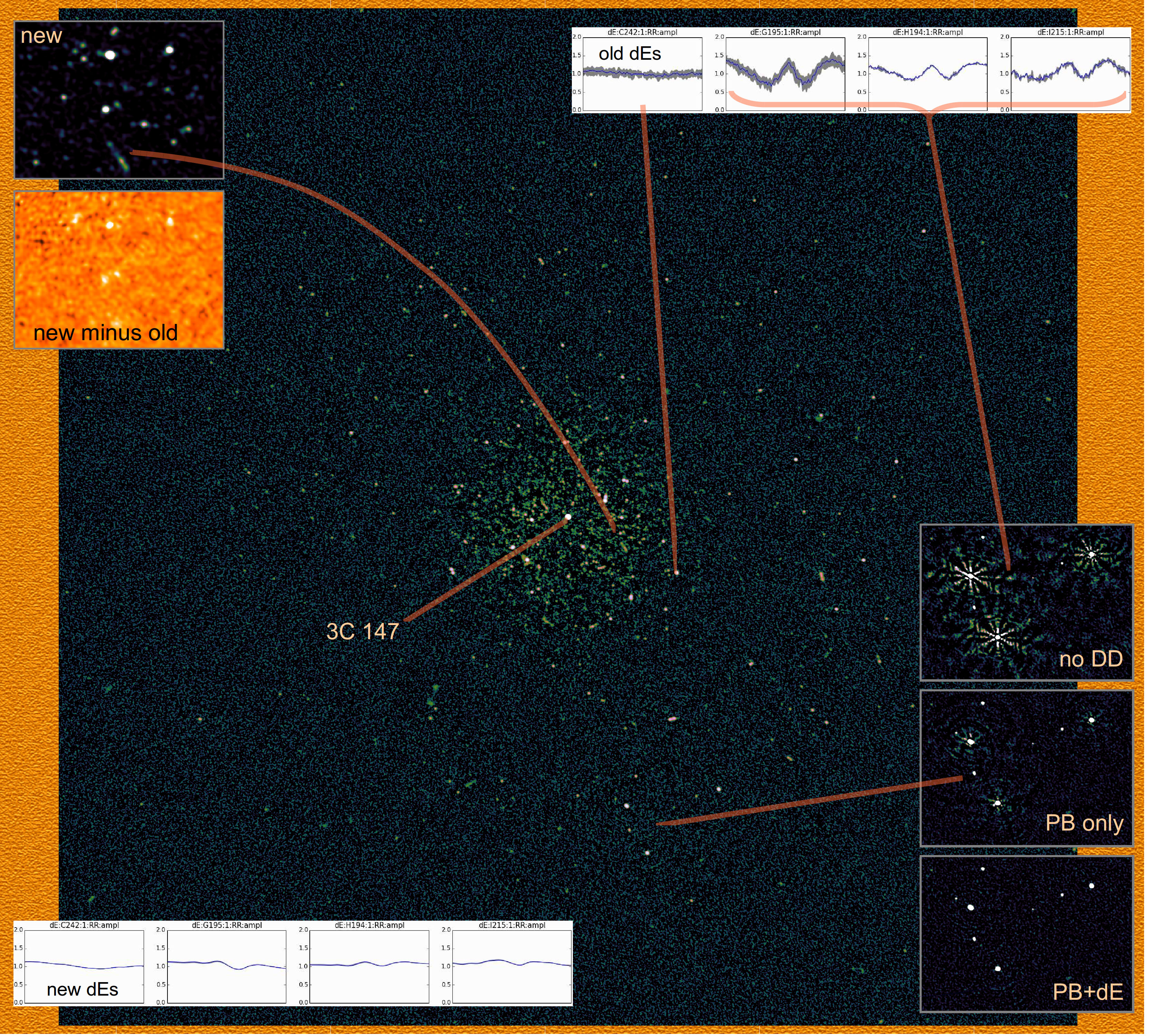Daily Image
06-03-2015Of Beams & Blue Ribands II: Depths and DoFs
| Submitter: | Modhurita Mitra, Sphesihle Makhathini, Griffin Foster, Rick Perley, Oleg Smirnov |
| Description: | Last year we presented a new world record dynamic range (DR) map of the field around 3C147 made from JVLA C- and D-config L-band data. It is about time to refresh this result. The map above boasts a modest gain in nominal DR (just under 5.1 million to 1). Such DR is difficult to capture in a single static image; the one above is rendered in a log-scale colourmap from 0 to 10 mJy. The map is about 3 degrees across, and we can see sources imaged well into the second sidelobe of the primary beam (PB). Most of the gain in DR is due to all of the available bandwidth now having been processed, or about 640MHz in total (the rest of the 1GHz observable bandwidth being lost to RFI), as compared to 192MHz in last year's map. In technical terms, however, the new map represents a completely new calibration pipeline, one that fully incorporates a wideband PB model into the calibration, and corrects for direction-dependent effects (DDEs) while solving for orders of magnitude fewer degrees of freedom (DoFs). For an apples-to-apples comparison, we also present versions of the 192 MHz image made with the new-style pipeline and the old pipeline (rendered in linear scale close to the noise). The crucial difference in the new pipeline is that it includes a full-Jones PB model (in this case, produced by Walter Brisken's cassbeam software, though any model pattern can be plugged into MeqTrees via FITS cubes), accounting for the rotation of the PB pattern on the sky, as well as scaling of the PB with frequency. In addition, we apply the MT-MFS algorithm during deconvolution to recover apparent source spectral indices, and explicitly correct these for PB frequency scaling. The 2014 pipeline used solvable differential gains ("dE's") to absorb all these effects, while applying them to only a subset of "troublesome" brighter sources (marked by crosses in the comparison images). The new pipeline applies a rotating, frequency-dependent PB to all sky model sources during calibration, which takes care of the bulk of the DDEs, while an additional layer of dE's is applied to the "troublemakers" to accommodate some residual DDEs (such as pointing error, and actual deviations from the model pattern). This is illustrated by the three insets on the bottom right: these show sources without any DDE treatment, then with a PB model applied, and finally with a PB model and extra dE solutions. The immediate benefits of using a proper PB model are threefold. Firstly, all sources, not only those with explicit dE solutions, become largely DDE-free (compare especially the first PB sidelobe in the new-style and old-style images). This, secondly, means that we've taken a big step towards the Platonic ideal of calibration -- our outputs are a source catalog with accurate intrinsic fluxes and spectral indices, and an almost noise-like residual map. By contrast, the dE-only approach absorbs intrinsic source properties into directional gain solutions, thus destroying astrophysical information. Thirdly, the remaining dE solutions need to account for a much smaller effect, and can therefore be made much "stiffer", i.e. with fewer solvable degrees of freedom (in fact, exactly a factor of 60 fewer in the new-style map). The upper right and lower left insets show typical old- and new-style dE solutions for four particular sources. Cutting down on the number of solvable DoFs reduces such undesirable artefacts as source suppression and ghosts. This is plain to see in the upper left insets, which show a small section of the new map, and a difference image w.r.t. the old map. It is clear that the new pipeline consistently recovers more flux. While a few subtle technical challenges remain (e.g. some deconvolution problems around faint complex sources are now apparent -- though some might call this a luxury problem, since at lower DRs the 3C147 field is notorious for being point source-only!), we don't expect to wring any significant new DR records from this data, since our map is already confusion-limited at the centre of the field. With a few hours of B-config time, we could forge on deeper, but until then, the Blue Riband stands up for grabs at a bit over 5 million. |
| Copyright: | Rhodes University / SKA SA / NRAO |
| Tweet |  |
